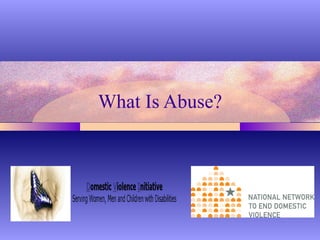
Understanding Domestic Abuse: Types, Cycles, and Resources for Victims
- 2. What is Domestic Violence? • A pattern of escalating abusive behavior from one partner to another in an intimate relationship • Control by one partner over another in an intimate relationship
- 5. Facts About Domestic Violence
- 6. Fact: Almost four million women are beaten in their homes every year by their male partners. Although the first violent incident may not be severe, once battering begins, it tends to increase in severity and frequency, sometimes leading to permanent injury or death. What may begin as an occasional slap or shove will turn into a pushy down the stairs, a punch in the face, or a kick in the stomach. Fact: Battering is not about anger or losing control; it is an intentional choice focused on maintaining power and control in the relationship. Batterers manage not to beat their bosses or terrorize their friends when they are angry. Fact: The batterer is responsible for the violence – not the victim. People are beaten for breaking an egg yolk while fixing breakfast, for wearing their hair a certain way, for dressing to nicely or not nicely enough, for cooking the wrong meal, or any other number of excuses. These incidents do not warrant or provoke violence. Even when you disagree, you do not deserve to be beaten. People who are battered do not want to be beaten. Fact: Violence does occur in same sex relationships, and the issues of power and control are similar to those found in heterosexual relationships. Homophobia allows us to trivialize the violence in same sex relationships and compounds the effects of the violence for the victim. Fact: Substance abuse is involved in about half of all domestic violence incidents. Although drugs or alcohol may lower a person's self-control, they do not cause violence. Batterers often use drugs or alcohol as an excuse or permission to batter and to avoid responsibility for their abuse. Fact: Because violence inflicted upon a woman by her partner is treated much differently than violence inflicted by a stranger, batterers are not always arrested. Traditionally, police were more likely to file a report if the offender was a stranger, rather than an intimate partner. Fact: Battering crosses all economic, educational, ethnic, sexual orientation, age, and racial lines in equal proportions. There is no "typical" victim. Fact: Batterers generally lead "normal" lives except for their unwillingness to stop their violence and controlling behavior in their intimate relationships. Batterers do not batter because they are crazy
- 8. • Fear of being beaten more severely • Threats against her life, the lives of her family and loved ones • Dependence on the abuser for food, shelter, and other necessities • The feeling that she has no one to talk to or that people will not believe her • The belief that a child needs both parents in the same household • Religious commitment reasons • Fear of not being able to care for herself or her children • Threats of suicide by the abuser • The belief that things will get better • The belief that no one else can love you • Fear of family and friends becoming ashamed of her if she leaves • Feelings of embarrassment, shame, and humiliation • She does not want anyone to know she is being abused • Fear that others will think that you are stupid for becoming involved in an abusive relationship • The thought that if the relationship does not work it is the woman’s fault • Wanting to “fix” the abuser
- 9. The Cycle of Violence
- 10. Factors of Why Victims with Disabilities Stay
- 11. Tactics of Abuse Specific to People with Disabilities or who are Deaf • Physical – withholding food, personal care, medications; overmedicating or misusing medication or cause pain. • Sexual – unwanted/forced touching and/or intercourse; forcing sterilization, pregnancy, or abortion. • Isolation – controlling access to or breaking AT devices; taking away service animals; misusing meds for sedation; firing/harassing aids/assistants • Emotional – Using ridiculing language; disclosing disability; threatening to harm service animals; discounting feelings by attributing them to disability.
- 12. Tactics of Abuse Specific to People with Disabilities or who are Deaf • Financial – coercing into signing checks or legal documents: controlling access to or misusing money: exploiting power of attorney. • Exploiting the Children – exploiting disability to get custody; forcing/teaching children to ridicule. • Exploiting Privilege – exploiting lack of accessible service providers; making unilateral decisions. • Minimizing, Justifying, Blaming – denying abuse; blaming disability as cause of abuse; minimizing challenges caused by disability.
- 13. Tactics of Abuse & Assistive Technology • Abuser may limit access to, tamper with, or destroy devices specifically to as a tool to: • physically and emotionally isolate survivor • prevent success in work or school; create increased barriers to independence and daily living • limit or prevent communication with others (especially police, counselors, etc.) • retaliate, frighten, or punish 13
- 14. Navigating the Community: Recognizing Challenges • Timelines: Everything takes longer. • Barriers: Will I be recognized as a candidate? A participant? An equal? • Access: Can I even get in? Can we communicate? • Stigmas: Will I be discriminated against? Will people see me as vulnerable? • Transportation: Can I even get there? Can I get around?
- 15. Resources • Domestic Violence Initiative: www.dviforwomen.org • National Network to End Domestic Violence, Technology Misuse & Abuse Information: www.nnedv.org/safetynetdocs • National Domestic Violence Hotline: 800-799-SAFE(7233) / TTY: 800-787-3224